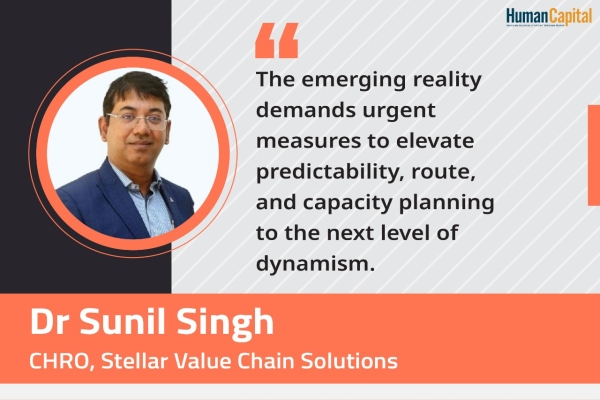One may have several technology solutions available at the click of a mouse and the swipe of a credit card, however, choosing the right solution for one’s own business need is harder than ever before.
CASE STUDY
The story of Sisyphus from Greek mythology is one that many are familiar with. Son of Aelous, he was the founder and first king of Corinth. He was considered by many to be a master of treachery and supremely intelligent. His cunning acumen enabled him to cheat death not just once but twice! For this transgression, he was punished by the God Zeus and was destined to roll a boulder up a hill for eternity. Each time he laboriously rolled the massive rock up the hill and almost reached the pinnacle, it rolled back all the way down to the foothills, needing him to start all over again.
But why the reference of Sisyphus in the write up about HR Tech? The difference between the two is as stark as that between chalk and cheese. Between the occurrence of the two, more than a few centuries have passed. The only commonality that appears on the surface is the existence of the letters ‘o-l-o-g-y’ in ‘Mythology’ and ‘Technology’. But that is not the only reason one is alluding to a Greek in this article. Read on and you will know why.
The truth is that over the last decade, a typical HR professional who has learnt his art through practical application at the workplace, would not have found his predicament any different than that of Sisyphus.
Subsumed by the weighty pressures of paper, spreadsheets and databases, HR professionals have suffered for years. Surmounting clerical errors that invariably arise when data is moved from one form to another, they have soldiered on. For instance, a critical HR process such as the annual increment cycle. Heavy on analytics, this exercise requires immense focus, stability and resilience to execute. Even when using a spreadsheet, it can consume the hardiest of professionals. An exercise that typically takes about two to three months (depending on the size of the organisation and the HR team) needs to be recreated from scratch every year with added complexities. Much like what revered Sisyphus was reduced to doing!
To be fair, the situation is not all that bleak. Many large organisations have moved on to deploying automated solutions to help the HR teams manage the hire to retire lifecycle of employees. This has truly been every HR practitioner’s dream come true. A plethora of hi-tech platforms that start connecting with employees before they even join the organisation (during the recruitment stage) and continue to stay bonded to them as they navigate the corporate corridors. These software engines even continue in the employee’s ‘corporate afterlife’ as they exit the organisation and get their much-loved ‘full-and-final settlement’.
These platforms automate the mundane and clerical activities that clog a huge part of the HR team’s bandwidth. As the icing on the cake, they also provide insights and analytics that HR professionals can use to further enhance their employee-centric initiatives and touchpoints. What started as a trickle just about five years ago in our country, has expanded into a flood that is often overwhelming.
Struggling to manage your employee rewards programme? There is a solution available for you.
Unable to drive candidate referrals from employees to meet your hiring requirements? You will be quickly directed to yet another platform available to solve the problem.
But it is rightly said - the problem of plenty is no better than the problem of scarcity. So today, while as an HR leader, one may have several technology solutions available at the click of a mouse and the swipe of a credit card, choosing the right solution for one’s own business need is harder than ever before. In the middle of a conundrum like this, where does one begin one’s journey down the circuitous HR tech path? Let us attempt to answer that. The right way to approach this process would be as follows.
1. Identify and understand the business need
To begin with, you must be very clear about the problem you are trying to address. As any doctor worth his salt will advise, the symptoms are often not this reflective of the underlying disease. Therefore, take enough time to deep dive and unearth the issues at the root. Typically, these issues are the ones that have a cascading impact on employees, and therefore, on the future of the organisation. If due thought and attention is not given at this stage, there can be disastrous consequences subsequently. Not only is the organisation likely to lose money on faulty deployment, but it is also equally likely to lose time and people, both of which are invaluable in these times.
2. Scout the landscape
As mentioned earlier, thanks to some very enterprising technologists there are a number of very comprehensive, robust and relevant HR tech solutions available in the marketplace. Do your research online and offline. Speak to existing customers of the solutions that you are evaluating to get first hand feedback. Refer to HR centric publications such as this one to gain insights and reviews of varied platforms.
3. Compare different platforms
During your research process, without doubt, you will come across solutions that are quite alike. Ensure that you do an objective analysis that enables you to compare these on various parameters that are critical to your decision-making process. More often than not, this would include functional parameters and the pricing of the solutions. Noting these and building a comparative chart will enable you and other colleagues involved in the decision-making process to make an informed call about which solutions are to be evaluated in greater depth.
4. Pilot test the shortlisted tools
Once you have zeroed down onto the two or three potential solutions that you might procure, it is a good idea to do a pilot test. Most HR tech vendors would be more than pleased to help you test run their product for a limited period. Make sure that your pilot run is executed in a scenario that is representative of your full-scale environment, since eventually, it would need to operate in that space.
5. Deploy the ideal solution
Once you have evaluated the potential solutions via the pilot test runs, you can confidently move towards fullscale deployment. Make sure that you factor in relevant timelines, resources and support systems that will be required to ensure smooth deployment. No amount of pre-preparation will be less. Even at the cost of being considered conservative or cautious, you must make ensure that you cover all the bases.
Having followed these steps, the chances of a successful deployment, greatly increase. Notice that one has not mentioned that success is totally assured. The reason for that is that there is a dynamic environment in which one is operating when it comes to people management. Not only is the internal environment of an organisation liable to change, but the external pressures also continue to prod and push from various ends. Business practices evolve, market dynamics turn, regulations change, and, most importantly, aspirations of the workforce change.
Therefore, the right perspective to carry when considering the installation of an HR tech solution in your organisation is to understand that it is not a ‘project’. It is quite simply put, a ‘journey’. There is abundant effort that goes into the exercise from the ‘need identification’ stage to the final ‘deployment’ stage. This is no less that a full-fledged ‘transformation’ and it enables HR leaders to ensure that their organisations remain relevant for the new world of business. The added benefit? Well, this will ensure that their teams do not continue to face the sad predicament that drained blood and sweat from Sisyphus. They will be quite likely free from the drudgery of mundane, repetitive, operational tasks and able to truly enjoy their work and add value to their organisations.
.jpg)
Do you think hybrid work arrangements would be a common feature of the workplaces going forward?
Trending
-
SBI General Insurance Launches Digital Health Campaign
-
CredR Rolls Out 'Life Happens' Leave For Its Employees
-
Meesho Announces 30-Week Gender-Neutral Parental Leave Policy
-
Microsoft Unveils Tech Resilience Curriculum To Foster An Inclusive Future
-
60% Indian Professionals Looking For Job Change Due To COVID: Survey
-
SpringPeople And Siemens Collaborate For Digital Transformation Push
-
86% Professionals Believe Hybrid Work Is Essential For Work Life Balance: Report
-
Almost 1 In Every 3 People's Personal Life Affected Due To Work Stress
-
Meesho Rolls Out Reset And Recharge Policy For Employees
-
80% Of Talent Leaders & Academics Say Pandemic Changed Skill Needs For Youth: Report
-
Hero Electric Rolls Out 'Hero Care' Program For Employees
-
Human Capital In Collaboration With ASSOCHAM Hosts Virtual Conference
-
IKEA India, Tata STRIVE Collaborate To Create Employability And Entrepreneurship Opportunities
-
SAP India, Microsoft Launch Tech Skilling Program for Young Women
-
DXC Technology, NASSCOM Collaborate For Employability Skills Program
-
Lenskart To Hire Over 2000 Employees Across India By 2022
-
Mindtree Launches Learn-and-Earn Program
-
Tata AIA Extends 'Raksha Ka Teeka' To Its Employees
-
Swadesh Behera Is The New CPO Of Titan
-
NetConnect Global Plans To Recruit 5000 Tech Professionals In India
-
Hubhopper Plans To Hire 60% Of Indian Podcasters By 2022
-
Corporate India Needs More Women In Leadership Roles: Report
-
Aon to Invest $30 Million and Create 10,000 Apprenticeships by 2030
-
Tech Mahindra Launches ‘Gift a Career’ Initiative for Upskilling of Youth
-
40% Women Prefer Flexible Working Options in Post-COVID World: Survey
-
3 out of 4 companies believe they can effectively hire employees virtually: Report
-
Vodafone , CGI and NASSCOM Foundation launch digital skills platform
-
Odisha: Bank, postal employees to deliver cash for elderly, differently-abled persons
-
Skill India launches AI-based digital platform for "Skilled Workforce"
-
Hiring activity declines 6.73% in first quarter: Survey
-
70% startups impacted by COVID-19 pandemic
-
Bajaj Allianz Life ropes in Santanu Banerjee as CHRO
-
Over 70 Percent MSMEs look at cutting jobs to sustain businesses
-
93 Per Cent employees stressed about returning to office post-lockdown
-
Johnson & Johnson India announces family benefits for same gender partners
-
Indian firms turning friendly towards working mothers
-
Welspun India names Rajendra Mehta as new CHRO
-
Wipro partners with NASSCOM to launch Future Skills platform



Human Capital is niche media organisation for HR and Corporate. Our aim is to create an outstanding user experience for all our clients, readers, employers and employees through inspiring, industry-leading content pieces in the form of case studies, analysis, expert reports, authored articles and blogs. We cover topics such as talent acquisition, learning and development, diversity and inclusion, leadership, compensation, recruitment and many more.
Subscribe Now












































Comment